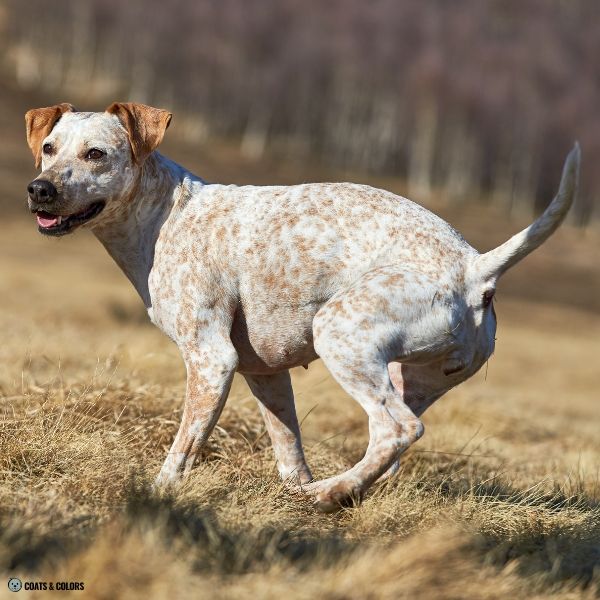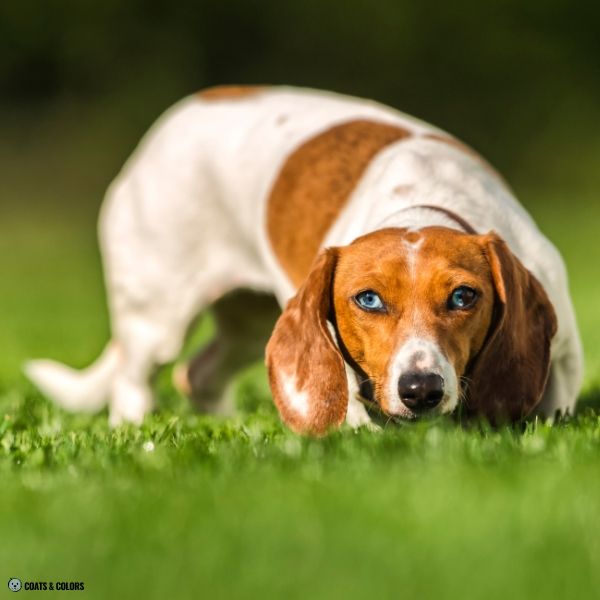Sable merle can be very striking in young puppies, but merle can be difficult to spot or even “hidden” in adult dogs with a sable pattern. That is because most merle alleles can only affect eumelanin. And many adult sable dogs don’t have a lot of eumelanin in their pattern.

The Sable Pattern
To understand how merle affects a sable pattern, you first need to understand what sable actually is.
Pigment Types
Sable is a distinct pigment distribution pattern in the A locus series.
There are both types of pigment in a sable pattern, eumelanin and phaeomelanin.
Eumelanin is by default a black pigment. Its color can be modified to brown, blue, or lilac.
Phaeomelanin is a reddish pigment. It can be modified to anything from off-white and chestnut red.
When we talk about coat colors, by “black” we mean eumelanin and by “red” we mean phaeomelanin. Just keep in mind that these pigments also come in other than their default colors.
The examples in this post show black-based sable patterns.

Clear Sable & Shaded Sable
The sable pattern tells pigment cells when and where to produce each type of pigment.
Most of the hairs on a sable dog will be solid red.
But the guard hairs in the dorsal areas of the sable pattern can have black tips or “sabling“. Some sable dogs can also have some darker roots or solid black hairs intermingled in their red coat.

The amount of visible black distinguishes a clear sable and a shaded sable dog.
A clear sable has very little eumelanin in its adult coat.
And dogs with sabling can have varying amounts of black-tipped hairs. Most of them are located on their forehead (where it can form a widow’s peak), along their back, and on top of their tail.

Sable is a very variable pattern.
A shaded sable dog can have anything from a light dusting of black tips on their back to an almost black-looking coat. The black hair tipping can be especially pronounced in long-haired dogs.



And the extent of sabling can sometimes change throughout a dog’s lifetime.
The shaded sable pattern on its own almost never causes any black beneath the eyes or down the legs. This is an easy way to tell a sable apart from an agouti dog.
Sable Puppy Coat
All sable dogs can be born with a lot of black overlay all over their body.
Newborn sable puppies can look almost solid black.
Some look like they had tan points when their black overlay eventually fades.

Some clear sable puppies already have less black in their coat which will not return once it’s gone.
The black shading might only return if the dog is a shaded sable.



The Sable Merle Pattern
Merle does not change where and when the pigment cells produce which type of pigment.
The pigment distribution in the sable pattern stays the same if a dog is also merle.
But merle can affect how well pigment cells can do their job.

Merle will disturb pigment synthesis in random areas. This gives merled patches with a lighter pigment color or non-merled patches where the original base color is visible.
But most merle genotypes can only affect eumelanin. Meaning, merle often lightens random patches in only the black portions of a pattern while the the red portions are not affected.

Most merle alleles don’t cause any change to phaeomelanin.
And that’s a problem because sable in most adult dogs is mostly phaeomelanic and doesn’t always have that much eumelanin, depending on the dog being a clear sable or shaded sable.

Most merle genotypes will not cause a visible phenotype on a sable pattern. Any sable puppy from a merle breeding can have a merle allele without having a visible pattern in its adult coat.

The most common classic merle pattern (M/m) very often gets “masked” by a clear sable pattern. Only sable dogs with some black hair tipping in their adult coat might have a visible merle pattern.

The more heavily shaded the sable dog, the more likely it is that some merled patches may be visible. Very sparsely shaded dogs may only show a very faint hint of a merle pattern.

Very many sable merle dogs only show a pattern as long as they have their darker puppy shading.
The merle pattern will disappear as soon as the puppy loses the black shading and clears into a predominantly red coat. Without puppy pictures, you may have no clue that the dog was merle.

The merle is still there, it is just not visible when looking at the adult dog (unless the sable dog also black brindle striping or has a black mask that can show its merling).

And some sable merle dogs have no merling at all even at birth.
Maybe they already have a mostly red coat when young. Or maybe they have a non-expressing allele or a minimal merle pattern or a mosaic genotype. Merle can be quite tricky at times.
Sable merle can create what is called “a “hidden merle“.

Pigment colors other than black (eumelanin) and red (phaeomelanin) can make it even harder to spot a merle pattern. Dogs can be black, brown, blue, or lilac sable depending on their B locus and D locus (or Cocoa in Frenchies). Some have progressive graying on top. And they can have anything from white, cream, tan, yellow, to deep red phaeomelanin depending on red intensity.
Now imagine these dogs were merle:



Only a few of all possible merle combinations are strong enough to cause blue eyes or show some kind of merle pattern or delete pigment to white even on a solid red dog.





And even in a heavily shaded sable pattern or puppy coat, there is just no guarantee a dog isn’t merle anyway just by looking at it. There are some merle genotypes that can express in a way that makes them hard to see even on a darker sable coat (such as minimal merle or atypical merle).
Sable Merle Breeding
A sable merle with a hidden pattern can lead to problems in breeding if it is assumed to be a non-merle because its pattern is not visible. Always test your dogs before breeding with merle!
Some breed clubs discourage breeders from producing sable merles (especially before testing was available) to avoid having dogs with a masked/hidden merle phenotype in the breeding population.

There are different alleles in the Merle series that can create a spectrum of patterns.
Only a very, very small number of merle alleles and their combinations might be visible in a sable pattern at all. Never assume a dog is non-merle just because his coat looks solid!
The expression of merle can range from non-expressing phenotypes to muted patterns to a classic marbled coat to tweed patterns or the point where pigment gets deleted to white.
Cryptic merle alleles (Mc, Mc+) are non-expressing. These truncated alleles are the shortest in the merle series. They are “too weak” to create a visible merle pattern on their own.
One copy of a cryptic merle (Mc/m, Mc+/m) allele doesn’t affect pigmentation.
Atypical merle alleles (Ma, Ma+) can be non-expressing, or they can cause all-over diluted look (without changing the nose pigment) or they can give a muddy merle or muted pattern.
One copy of an atypical merle allele (Ma/m or Ma+/m) only affects eumelanin.
Classic merle (M) gives a Merle pattern with lightened merled patches and unaffected non-merled patches. This is what most merle breeds go for since it gives the traditional marbled coat.
One copy of a classic merle allele (M/m) only affects eumelanin.
Harlequin merle (Mh/m) has a variety of expressions. It can cause pigment deletion to white in some areas, give a classic pattern or it can give a minimal merle phenotype.
The Mh is the longest in the Merle series. It can also sometimes affect the phaeomelanin in red areas of the coat and produce patches of lighter and darker tan in these areas.

With seven alleles (m, Mc, Mc+, Ma, Ma+, M, Mh) there 28 possible allelic combinations.
Not all homozygous merle genotypes are a problem.
A Mc/Mc dog will look and breed like a non-merle. And a M/Mc dog will look and breed like a normal M/m dog because the shorter Mc allele is too short to add anything to the merle effect.
But the merle effect can add up in dogs that have two stronger merle alleles.
In total, 14 of the 28 merle combinations can delete pigment even in red areas. This means, only a few combinations of stronger merle alleles can also affect the red pigment in a sable pattern.

The effect of merle in homozygous dogs ranges from non-expressing (e.g. in Mc/Mc) to tweed patterns (e.g. in M/Ma) but can escalate into a double merle situation (e.g. in M/M or Mh/M) with a high risk for possible vision or hearing impairments when merle causes too much pigment deletion.
Homozygous merle puppies are often produced on accident in breedings where one parent had a solid-colored coat and was considered a non-merle (m/m) without testing, but actually is not.
This can happen when the “solid-looking” parent is non-expressing (e.g. Ma/m) or has a minimal merle phenotype (in Mh/m or merle mosaicism) or has a hidden merle phenotype (where merle is there but not visible due to a clear sable or recessive red or extensive white pattern that does not show merle).
To avoid producing homozygous merle with an undesired pattern or double merle puppies, the simple solution is to also test the assumed non-merle parents before breeding. Better safe than sorry!
A sable can be a hidden merle without you realizing it. If a sable dog is bred, its Merle locus genotype is something you want to know before placing him to another merle partner!
I also recommend maybe testing sable puppies from merle breedings before placing them in a new home. That way the new puppy owners know what they are dealing with and can plan accordingly.
If you have any questions about sable merle I recommend you ask in the Merle Facebook group.
Patterns Similar To Sable Merle
Some coat colors can be similar to a sable merle pattern.
Some light agouti or faded saddle or agouti domino patterns can have a sable-like distribution of red and black pigment. Combined with merle, these patterns can be a little hard to distinguish.

Patterns such as brindle merle or seal merle can give a reddish coat in merled areas (but dogs can have black spots in areas where there can be no black in a normal sable pattern such as the lower legs).
Finally, all recessive red merle dogs will have a hidden merle phenotype. They always have a solid red coat even when newborn and can (almost) never show any hint of their merle pattern.
Learn More

Hi! I’m Steffi. I am a biologist and a big time dog nerd. You are curious about coat color genetics? You’ve come to the right place! Read more.







